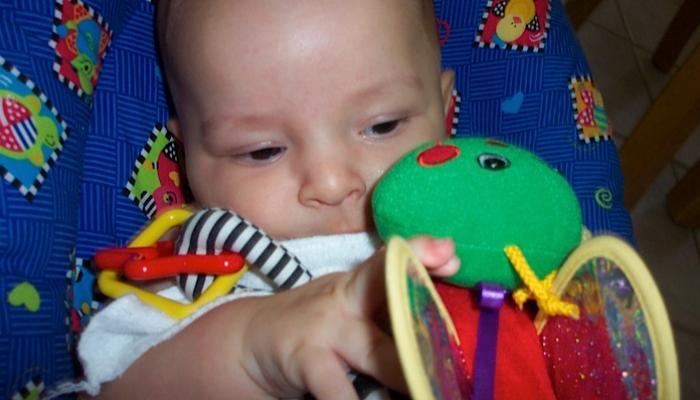Helping Your Blind Baby Learn How to Reach for Objects

Reaching towards objects using vision and/or sound is an important early step toward independent crawling, cruising and walking. It also contributes to a beginning orientation to the environment and an understanding that objects are permanent and do not magically appear and disappear out of nowhere.
Teaching your baby to routinely reach for objects instead of expecting them to be given accomplishes the following:
- Reinforces the understanding of what objects are and where they come from.
- Builds on functional vision and sound localization.
- Enhances visual/motor concepts and skills.
- Increases active involvement.
- Lays the groundwork for crawling and walking.
You can foster reaching by using the simple Show-Tell-Reach method throughout your daily routine, whenever time allows. Use this approach during mealtimes, dressing, bathing, toy play, and many other activities… any activity involving an object or objects that the child will be experiencing directly:
- Slow down your pace during the activity. Provide lots of “wait” time to give your child time to respond.
- Tell your child what you are about to do.
- Hold the object in front of your child and wait for him/her to look at it,
or make a sound with the object, while telling your child what it is. - Wait 3 to 5 seconds for your child to reach; if no reaching occurs wiggle the object and/or make the sound again.
- If your child reaches proceed with the activity. If your child needs help guide his/her hand to the object (from the elbow or by using hand-under-hand technique) then proceed.
Here’s an example…
Mom: “Jason, it’s time for your bath! Here’s your washcloth. Listen!” (or, “Look!”)
(Mom squeezes and wiggles wet washcloth and waits a few seconds.)
(Jason looks or stills to listen.)
Mom: “Reach with your hand!”
(Mom waits a few seconds, and then makes a sound with the washcloth or wiggles it again, and asks him, again, to reach.)
(Jason reaches.)
(If Jason does not reach after 2 requests, mom says…)
Mom: “Let me help you reach for your washcloth!”
(Mom guides Jason’s hand to the object by guiding from his elbow.)
Mom: “Good! There it is. You got it! Can you help me wash your tummy?”
Other objects that may provide practice with reaching include:
- A spoon full of food at mealtime.
- A cup of juice at snack.
- The tissue before a nose-wipe.
- The new diaper at change time.
- Any toy during play.
- A comb or brush after the bath.
- Your baby’s bottle anytime throughout the day.
Susan Shier Lowry has worked as an O&M specialist for children from birth to five years and their families for over twenty years. She has given presentations and published, nationally and in England, on O&M for infants and preschoolers, including promoting the development of independent walking, using playspaces, teaching about changes in surface depth, and introducing protective/detective devices. She thanks her wonderful students and parents for teaching her what they need. You can contact Susan at susan.lowry@esdb.nc.gov
Related Posts

Eye Conditions and Syndromes, Visual Impairment
Neuralink Announces Plans to Restore Sight to the Blind with Brain Chip
Elon Musk’s company Neuralink has announced plans to begin human trials of its new “Blindsight” brain chip by the end of 2025.

Visual Impairment
The Gift of Understanding: How a Young Child Helps His Blind Father Navigate Life
When a parent is blind, it’s natural for people to wonder how their sighted child will adapt. Will they struggle to understand their parent’s needs? Will they feel burdened by...

Braille and Literacy, Toys, Visual Impairment
24 Braille Toys for Kids Who are Blind
Everything from alphabet blocks to raised line coloring pages and activity books to puzzles to card and board games... and so much more! And it's all in braille ready for...